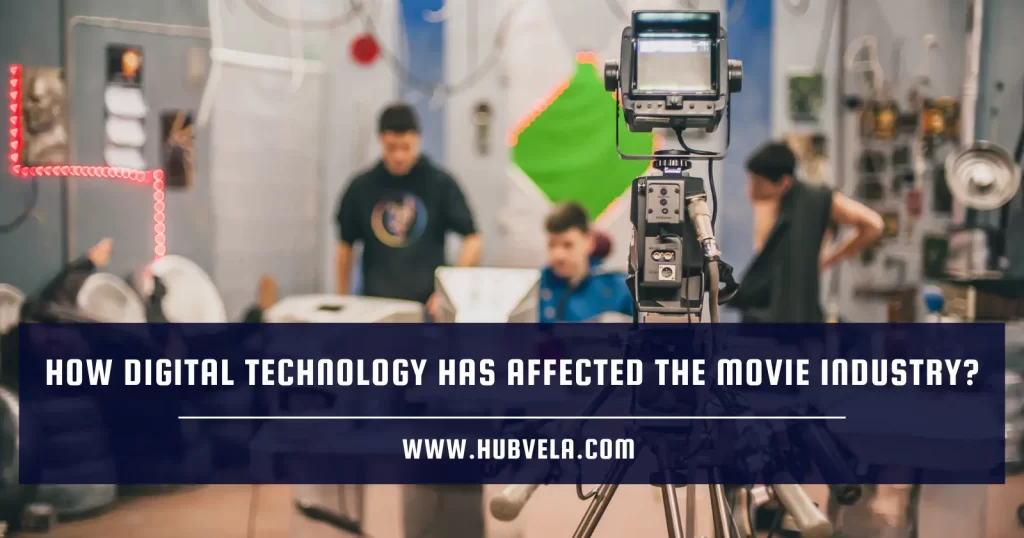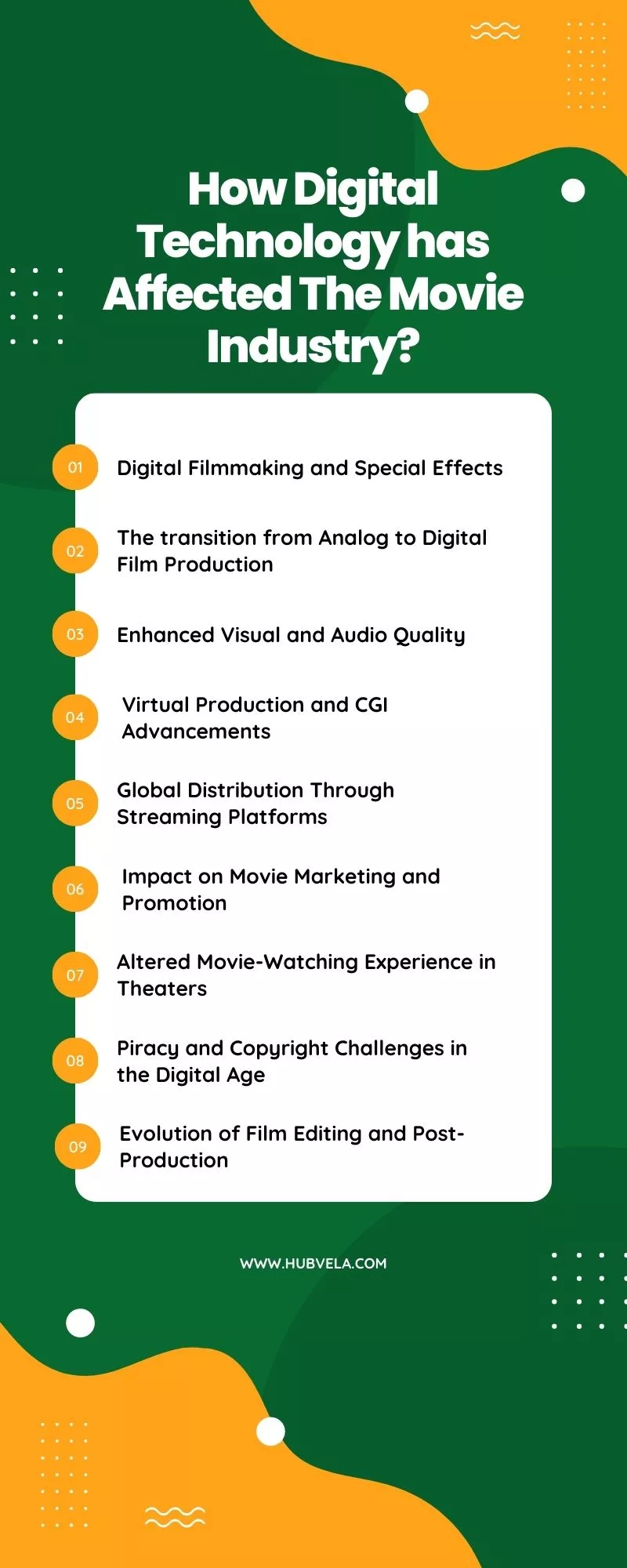The film industry has undergone a significant transformation in recent years, thanks to the advent of digital technology. From the way movies are made to how they are marketed and distributed, technology has revolutionized all aspects of filmmaking.
The impact of digitalization on the film industry has been profound, and it has brought about a paradigm shift in the way movies are produced and consumed.
The use of advanced technologies has improved the qualitative aspects of moviemaking, ensuring engaging and crisp visuals, enhanced sound effects, and easier editing tools.
Moreover, digital film distribution has made it possible for filmmakers to distribute their movies to a larger audience with almost no additional cost.
From the viewer’s perspective, technological change is very much visible, with innovative screening interfaces like 3D spectacles, VR headgear, IMAX, and 7D, among others.
In this article, we will explore how digital technology has affected the movie industry and the various ways in which it has transformed the filmmaking process.

--Advertisement--
How Digital Technology Has Affected The Movie Industry (Infographics)

1. Digital Filmmaking and Special Effects
Digital technology has had a significant impact on filmmaking, particularly in the areas of digital cinematography and special effects. Here are some ways in which digital technology has changed the filmmaking process:
Digital Cinematography
- Digital cinematography is the process of capturing a motion picture using digital image sensors instead of film stock.
- Digital cameras allow cinematographers to shoot in higher definition, which enables viewers to take in more of the amazing work in set design.
- Going digital means foregoing the large canisters of film that used to be synonymous with filmmaking, which reduces costs and waste.
- Post-production is another area where digital technology has an advantage over film. Adding visual effects to film was often a precise art, where the effect had to blend seamlessly with what was being shot. This was a painstaking process that editors no longer go through. Digital effects are created and added to the shot within the same program or family of programs, which makes the process more efficient.
Special Effects
- Special effects are visual techniques used in films and other media to create an illusion that cannot be achieved in a live-action shot.
- Digital special effects (also known as visual effects or VFX) rely on computer-generated imagery (CGI), motion capture technology, green screens, and digital compositing. All to create realistic or fantastical visuals that would be difficult or impossible to achieve with practical effects alone.
- Digital special effects have become increasingly prevalent in modern filmmaking due to advancements in technology and the ability to seamlessly blend them with live-action footage.
- Digital technology has revolutionized the filmmaking process by enabling filmmakers to capture and edit footage in a more efficient and cost-effective way, and by providing new tools for creating special effects that were previously impossible.
2. The transition from Analog to Digital Film Production
The transition from analog to digital film production has been made possible by advancements in digital technology. Here are some ways in which digital technology has shaped the film industry:
Higher Definition: Digital cameras allow cinematographers to shoot in higher definition, resulting in clearer and more detailed images. This enhances the viewers’ experience and allows them to appreciate the work in set design.
Cost Efficiency: Digital production eliminates the need for large canisters of film, reducing costs associated with developing and editing film. Production companies can complete their shoot schedules with less waste, keeping projects under budget.
Editing and Visual Effects: Digital technology has revolutionized post-production processes. Editing film used to be a precise art, requiring seamless blending of visual effects with the footage. However, digital effects have made this process much more efficient and streamlined.
Distribution: The switch to digital technology has changed the way movies are exhibited. The majority of movie screens have transitioned from 35mm film to digital, and studios have adapted to digital distribution methods.
Flexibility and Creativity: Digital technology provides filmmakers with more creative freedom and flexibility. It allows for the use of various captivating techniques during the film production process, enhancing storytelling possibilities.
Improved Quality: Digital technology has closed the gap between analog and digital aesthetics. With advanced digital technology, the detail and feel of the film can be mimicked, resulting in high-quality digital productions.
Digital technology has had a significant impact on the film industry, transforming the way movies are made, distributed, and experienced.
It has opened up new possibilities for filmmakers and improved the efficiency and cost-effectiveness of film production.
The transition from analog to digital film production has been driven by advancements in digital technology.
Digital cameras allow for higher-definition filming, reducing costs and waste associated with traditional film production. Post-production processes, such as editing and visual effects, have become more efficient and streamlined with the use of digital technology.
The switch to digital has also changed the way movies are exhibited and distributed. Digital technology provides filmmakers with more flexibility and creative freedom, while also improving the overall quality of digital productions.
3. Enhanced Visual and Audio Quality
Enhanced visual and audio quality in movies can be attributed to advancements in digital technology. Here are some ways in which digital technology has contributed to improving the overall cinematic experience:
Special Effects: Digital technology has revolutionized the field of special effects in movies. Filmmakers now have access to a wide range of tools, such as CGI (Computer-Generated Imagery) and motion capture technology, which allow them to create immersive and visually stunning effects. These effects can transport audiences to fantastical worlds, create realistic portrayals of historical events, and enhance storytelling by adding emotional depth.
Digital Cinema: The advent of digital cinema has brought about significant improvements in visual quality. Digital cinematography involves capturing motion pictures using digital image sensors instead of traditional film stock. This allows for greater control over image quality, color grading, and post-production editing. Digital cameras also offer the advantage of shooting limitless footage without wasting costly film, resulting in more efficient and cost-effective film production.
Improved Sound Design: Digital technology has also played a crucial role in enhancing audio quality in movies. Sound design is an integral part of the filmmaking process, and digital advancements have made it easier to create immersive and realistic soundscapes. With digital sound recording and editing techniques, filmmakers can accurately represent the scene’s location and the actions of characters, further enhancing the overall cinematic experience.
Immersive Experiences: Digital technology has enabled filmmakers to create more immersive experiences for audiences. Techniques such as 3D, RPX, 4DX, and ScreenX have been made possible through digital cinema technology, allowing moviegoers to have a more engaging and immersive movie-watching experience.
Digital technology has significantly contributed to the enhanced visual and audio quality of movies.
It has opened up new possibilities for special effects, improved the overall visual quality through digital cinematography, enhanced sound design, and provided more immersive experiences for audiences.
These advancements have greatly impacted modern-day filmmaking and continue to shape the future of the industry.
4. Virtual Production and CGI Advancements
Virtual production is a filmmaking method that combines virtual and physical worlds to create movies. It is a broad term referring to a spectrum of computer-aided production and visualization filmmaking methods.
Virtual production is not just the technology itself, but also the methods through which it is used. Here are some key advancements in virtual production and CGI thanks to digital technology:
Real-time rendering: Real-time rendering is a powerhouse technical solution that allows changes to a digital environment to be made near-instantaneously, without the tediously long render times that once cramped the cinema CGI workflow.
LED walls: In high-end virtual production, the green screen is replaced by a massive LED screen. The high resolution of these screens makes any videos or images on them appear hyper-realistic.
Visualization: Virtual production allows directors to direct without knowing what the characters will ultimately look like, and there are often color inconsistencies between physical production and post-production when using green screens. By introducing digital assets via VP technology during physical production, the reliance on post-production is reduced and permits creative evolution.
Performance capture: Performance capture is a type of virtual production that captures an actor’s movements and facial expressions and translates them into a digital character.
Market growth: The market for virtual production tools is predicted to grow to US$2.2 billion in 2023, up 20% from an estimated US$1.8 billion in 2022. The virtual production market is driven by advancements in technology, including the development of real-time rendering and the increasing demand for high-quality content and cost-effective production.
Virtual production has uncovered several advantages that allow studios to build bigger, innovate more, and deliver high-quality results earlier in the production process.
It saves time and cost, and everyone can have a more complete understanding of the film, from previs to post.
5. Global Distribution Through Streaming Platforms
Digital technology has had a significant impact on the entertainment industry, including the distribution of content through streaming platforms.
Here are some ways in which digital technology has affected global distribution through streaming platforms:
On-demand content: Digital media has restructured working models for the music, television, film, and publishing industries, resulting in TV shows and movies gradually embracing the on-demand mode on every electronic device. This means that viewers can access the content at any time, from anywhere in the world.
Global reach: Technological advancements in fields like television and movies have helped video streaming services reach millions of viewers across the globe. This has allowed for a wider distribution of content and has made it easier for creators to reach a global audience.
Digital distribution: Digital music distribution has taken center stage, with the goal of getting music on major online music platforms such as Apple Music, Spotify, Tidal, and other streaming platforms. This has made it easier for musicians to distribute their music globally and reach a wider audience.
Pan-media entertainment: There is already a trend among global streaming platforms to create a pan-media entertainment and cultural service by increasing revenue streams and merchandise offering categories, as well as keeping subscriptions and attracting more viewers in the long run. This means that streaming platforms are expanding beyond just streaming content and are offering additional services to keep viewers engaged.
Digital technology has made it easier for content creators to distribute their work globally and reach a wider audience through streaming platforms. This has allowed for a more diverse range of content to be available to viewers around the world.
6. Impact on Movie Marketing and Promotion
The impact of digital technology on movie marketing and promotion has been significant. Here are some ways in which digital technology has transformed the film industry:
Digital Marketing: Digital marketing has become an essential tool for promoting films. It allows filmmakers to connect with the public and create a stronger connection with the audience. Digital marketing professionals can assess the effectiveness of their strategies using performance-related metrics, leading to informed decisions and improved efficiency of marketing efforts.
Cost Reduction: Digital technology has streamlined production schedules and reduced costs in the film industry. Filmmakers can now achieve visually stunning results even on a shoestring budget, thanks to technologies like drones and digital cameras.
Streaming Platforms: Digitalization has transformed how films are promoted and distributed. Small studios and independent filmmakers are increasingly using digital platforms to sell their films to distributors and target audiences. Streaming platforms have become a powerful tool for reaching a wider audience.
Social Media: Social media platforms have revolutionized movie marketing. Filmmakers can now leverage social media to create buzz, engage with fans, and generate excitement for their films. Social media provides a platform for expression and promotion, allowing the film industry to build momentum.
Targeted Advertising: Digital technology enables filmmakers to target specific audiences with their marketing campaigns. By carefully considering their target audience and crafting an advertising strategy, studios can reach the right people and generate more interest in their films.
Data Analytics: Digital technology allows for the collection and analysis of data, providing valuable insights into audience preferences and behavior. This data can inform marketing strategies and help studios make informed decisions about future campaigns.
Digital technology has revolutionized movie marketing and promotion. It has provided new avenues for reaching audiences, reduced costs, and allowed for more targeted and data-driven marketing strategies.
The film industry has embraced digital technology to connect with audiences in innovative and effective ways.
7. Altered Movie-Watching Experience in Theaters
Digital technology has had a significant impact on the movie industry, revolutionizing various aspects of filmmaking, including the movie-watching experience in theaters.
Here are some ways in which digital technology has altered the movie-watching experience:
Improved Visual and Audio Quality: Digital projection systems and advanced sound technologies have enhanced the visual and audio quality of movies shown in theaters. Digital projectors provide sharper and more vibrant images, while surround sound systems create a more immersive and realistic audio experience.
3D and IMAX: Digital technology has enabled the widespread adoption of 3D and IMAX formats in theaters. 3D movies offer a more immersive viewing experience, with images appearing to pop out of the screen. IMAX theaters provide larger screens and enhanced sound systems, allowing viewers to enjoy movies on a grand scale.
Real-Time Special Effects: Digital technology has made it easier for filmmakers to incorporate complex and realistic special effects into their movies. Computer-generated imagery (CGI) allows for the creation of stunning visual effects, such as realistic creatures, explosions, and fantastical worlds. This enhances the overall cinematic experience for viewers.
Digital Distribution: The advent of digital technology has transformed the distribution of movies. Digital copies of films can be easily distributed to theaters, eliminating the need for physical film reels. This has made it more convenient for theaters to showcase a wider variety of movies and has increased the accessibility of films to audiences.
On-Demand Viewing: Digital technology has also given rise to on-demand viewing platforms, such as streaming services and video-on-demand (VOD) platforms. These platforms allow viewers to watch movies at their convenience, either on their TVs, computers, or mobile devices. This has provided greater flexibility and choice for movie-watching.
Interactive Experiences: Digital technology has enabled interactive experiences in theaters, such as interactive seating, augmented reality (AR), and virtual reality (VR) experiences. These technologies allow viewers to engage with the movie in new and immersive ways, enhancing the overall movie-watching experience.
Digital technology has significantly transformed the movie industry, including the movie-watching experience in theaters.
It has improved the visual and audio quality, introduced new formats like 3D and IMAX, enabled real-time special effects, revolutionized distribution methods, facilitated on-demand viewing, and provided interactive experiences.
These advancements have enhanced the overall cinematic experience for audiences.
8. Piracy and Copyright Challenges in the Digital Age
The movie industry faces significant challenges related to piracy and copyright in the digital age. Piracy involves duplicating and distributing copyrighted materials without permission from the copyright holder, and it is widespread and tacitly accepted in some circles.
The entertainment industry loses billions of dollars each year due to copyright infringement, putting jobs and careers at risk.
Digital piracy first harms the original copyright holders, such as songwriters, music artists, moviemakers, game developers, software innovators, and other creators of new digital media products.
They lose money to those who sell pirated copies cheaply, and the theft of their work also discourages them from doing further creative work, defeating the fundamental purpose of the Constitution’s copyright provision.
The rise of technology has made it easier to access pirated content online, and it is simply easier to record pirated content altogether. The loss of revenue earnings as a result of piracy may ultimately reduce the incentives of content owners to produce new content.
Copyright law is powerless to halt the onslaught of Internet piracy, which will soon remove any economic incentive for creative activity.
Although new legislation is the most expedient response to the threats posed by new technologies, it probably will not hinder Internet piracy because the problem with piracy is not the inadequacy of copyright law.
To combat piracy, the movie industry can take several measures, such as:
Digital Rights Management (DRM): This is a technology that restricts the use of digital content and prevents unauthorized copying and distribution. However, DRM can be circumvented, and it can also limit the legitimate use of digital content.
Education and Awareness: Educating consumers about the negative impact of piracy on the movie industry and the creators of digital content can help reduce piracy.
Legal Action: The movie industry can take legal action against individuals and websites that engage in piracy. This can include civil liability and criminal penalties under federal law.
Piracy and copyright challenges in the digital age pose significant threats to the movie industry. The rise of technology has made it easier to access pirated content online, and copyright law is powerless to halt the onslaught of Internet piracy.
To combat piracy, the movie industry can take measures such as digital rights management, education and awareness, and legal action.
9. Evolution of Film Editing and Post-Production
The evolution of film editing and post-production has been greatly influenced by digital technology. Here are some key advancements and changes that have occurred:
The transition from Film to Digital: In the past, film editing involved physically splicing and cutting film reels.
However, with the advent of digital technology, the editing process has shifted to digital platforms, eliminating the need for physical film and making the process more efficient.
Non-Linear Editing: Digital technology has introduced non-linear editing (NLE) systems, which allow editors to manipulate and rearrange footage in a non-linear fashion.
This means that editors can easily access and edit any part of the footage without having to go through the entire reel.
Visual Effects: Digital technology has revolutionized the use of visual effects in film editing. Adding visual effects to film used to be a precise and painstaking process, requiring editors to blend the effects seamlessly with the footage. However, with digital effects, editors can easily integrate and manipulate visual effects, resulting in more realistic and visually stunning films.
Automation and Machine Learning: Recent advancements in digital technology have introduced automation and machine learning into the editing process. Tasks such as captioning and masking can now be automated, saving time and effort for editors.
Higher Definition and Quality: Digital cameras have allowed cinematographers to shoot in higher definition, resulting in films with better image quality and more detailed visuals. This has enhanced the overall viewing experience for audiences.
Cost and Time Efficiency: Digital technology has made film editing and post-production more cost-effective and time-efficient. The use of digital platforms eliminates the need for developing and editing the physical film, reducing costs and waste. Additionally, digital editing tools and software streamline the editing process, allowing for faster turnaround times.
Digital technology has transformed the film editing and post-production process, making it more accessible, efficient, and visually impressive.
It has opened up new possibilities for filmmakers and has greatly contributed to the evolution of the film industry.
Conclusion on How Digital Technology Has Affected The Movie Industry
In conclusion, digital technology has had a significant impact on the movie industry, transforming the way movies are made, edited, and distributed.
The use of digital imaging has revolutionized the industry, allowing for more engaging and crisp visuals.
The cost of filmmaking has been reduced, as filmmakers can shoot, edit, preserve, and store digital copies of their movies.
However, the use of digital technology also presents challenges, such as the need for appropriate financial resources and a strong cultural background to rely on.
Despite these challenges, digital technology has improved the achievements in the film industry, and it is driving the user experience.
The future of the industry is predicted to be even more influenced by technology, with the possibility of AI robots or software writing movie scripts and screenplays.
Overall, the impact of digital technology on the movie industry has been significant and will continue to shape the industry in the years to come.


